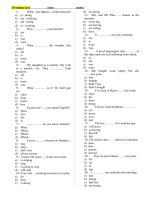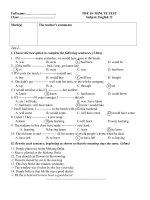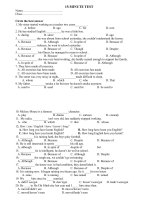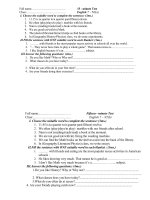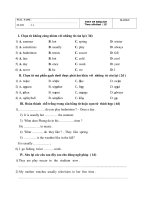15 minute abs workout
Bạn đang xem bản rút gọn của tài liệu. Xem và tải ngay bản đầy đủ của tài liệu tại đây (21.86 MB, 132 trang )
15 minute
abs
workout
Joan Pagano
»15minute
s
_r
Joan Pagano
lorDJn, New ~ MeIbc:une, Muich , IWId DeI1i
In rMmIJfY d my .w.
~!r;ftur t-hy MnIIIberg
~ Art EdbI AJh ttIpa
~~NOf/IIt~
..... EdIor ..IIMifIWUlIWn
US ~ ctwIIly LuIIIk
s.nb Art EiIaIt SUW\ ClcMri'G
.......... EdIDII o..n IIu..d"" .... ,
. . . . . . M EcItoIl Ctr'eIN I<8Ity
Art Chetur PaW I.J.AI
fIubII.tWng onctor ~ Jenwn
9tIIIa PI I 0 "'" It Rutl JerKhIOn
DTP DeiIIQnIir 90nifI ~
PI
gag, ConIroe.r AlIce Holaway
PI J ctIDI, EdIoII Luoa FraMNW
DVD produced for Darting IO'IdInIIIII')' by
Chrom. PrvJuctIo.. www.chlOO.lllprOOucliol18.com
Dir«:tlor Joel Miahoon
Prod ..., * , Hllnn8l1 Ctiandl8I'
DOP 88nIdIct Spence
c.rr.. EknIdIct Sptn::c, Joo McNBlIy
PI du d.... ' ..1 I It lrono Md'oI
GrIp TerryWllams
....-"'""- """""
_
............. \AcIorkI a.r..
o II I3uz:ww1It ~
..He 10 II n
. ."
..
Ban.bw
Fh1 PInertI:8l EdIion. 2009
tho lk1IBd S1aIas bot
--
OK-*"
375 HudIon snet
New 'foI1I. 10014
\
091011 10987ce4321
NJ4
ClorIIlII
Tact ~ 0 2009 Joan PagIn)
N ri!tD I'II88MJd
WItD..t ir'rItJ1g Itl8 r'i'jU IIlder ~ I'MfIroIIKt ato.te. ro
part of1his potfcstinn may be reptOduoad, Itoted n cr
Introduoacl nto It ratrWMIiIsyetem. or bill., jlt&d, n tnI form, or
by rJnf ITI8IrIS (electronic. rned"IenIcaI. pi ~. racordIng.
or otherwise), y"ffheJl..( the J;W1or written pal" iIssIo 1 ct boItllh&
cop'fI1gh1 owner and tho abcMl pubIshcr of tIU book.
Publish9CI n GI'8Ilt Britain Dy Doring Ki'id8r8Iay Lirited.
A catalog rooord for this book Is aveIabkI tom tho l..I:Jr;wy of
Congl8lllll.
ISBN 978-0-7:566-4203-7
DK booklIlIIII available at special dIecoLrts when pt.ftt\IIaed in
bUk for 881l1li promotions, ~, fl.r'ld-railirG, cr edu::al:k:riaI
use. Fa details, contact: OK ~ SpadaI MMuItB. 375
t-k.dson StnIeI:, New'rork. New York 10014 or Sj I r I •
-_......
"'rom,
At
pill' tUpw 118
n .... ec:tMIM rruI _ _ 1hII 16ijXJ i8UIy
r you . . .nj hIIIt:h probIIms 01'
condioo... t:enUI wilt! ycu docIa" bIIDII ....... U
fa" thet f:Mn actIona IWId safely.
~
!he adIYIieII ..,. ou1 in , . book. The i .... " ...... an.nd
in Ihi8 book cannot IepIk::e souncI jt.Idgn'Wtt and good daciIion
rreking. wt1iCtI (WI hsIP ~ Ihi riIk 01 ~
.nj ot
Pi"t"md .-'d tQni '"
Pri1ling ~ lb1
on. by Sheck WIti lOrtI
www.dk.cml
.
contents
_co
66
66
Foreword 6
Author Forewoo:I
Core
RoutIne
Core Bulco RoutIne
How to Use
Use this
ttls Book 88
Core
Core _BuIce Routho
Aoutho SUmmary
Sunvnary
Focus on the Belly 10
Core BasIcs
Bulco RoutIne
Aoutho FAQs
FAQo
_amy of you:
you- Abo
Abs 12
The Anatomy
Core Challenge
Challenge RoutIne
Crunch Assessment 14
Core Challenge RouHne
RoutIne SUmmary
Summary
Deep Abs
Abo Assessment
Asse6sment
Cora
Cono Challenge Routine FAQo
Cn.1Ch
Crunch Routine
16
18
Abs
Abo Roundup
Crunch Routine Summary
SummaIy
Crunch RoutIne
Routine FAQo
FAQs
Beach
. Ball
BoI RoutIne
Aoutho
_Ball
. BoI SUmmary
Summary
34
Risk
~sk Assessment
118
116
Pbs
Abo WoridOl'
Wotk fa( FItness
Atness
40
42
4:1
Perfect Positior"ing
PosItIonIng
AIls in
In EwIyday
Everyday lJfe
84
~I ~""'"
Resoorooo
~i
Index
inda><
118
120
ura
58
t58
Beach
. Ball
BoI RoutIne
Aoutho FAQo
114
122
124
124
126
128
Acknowledgments
Acknowiedgments 128
,~
~
~
..
...
82
82
88
110
112
106
author foreword
Throughout my career of 21 years in fitness, my clients have
shared a wide variety of intimate issues with me regarding their
health and well-being, and, naturally, their appearance, too.
A personal fitness training session is highly individualized and
very confidential, inviting people to feel free to discuss their most
important concerns about their bodies.
In these private conversations, I’ve learned that my clients
above all want to be healthy and stay in shape. A fit body is a
common goal, and if I had to name the most challenging area of
the body, I would say definitely it is the midsection. People of all
ages—from 15 to 95 years old—have asked me countless
questions about how they can reshape the abdominal region.
Women rank protruding bellies, expanding waistlines, and flabby
abs as three top trouble spots. Men want to know how to lose
their love handles and sculpt the ultimate six-pack.
It is very rewarding for both my clients and me when they
achieve the results that come from following a dedicated,
structured exercise routine. The exercises I’ve chosen for this
book target your midsection from every angle, using a variety of
positions to give you the best results, both aesthetically and
functionally. As you tighten your waist and tone your tummy with
these exercises, you will enjoy other benefits as well. When you
7
strengthen these muscles, you firm up, giving definition to your
torso. You also develop core strength, which improves your
posture, creates support for the lower back, and relieves upperback and neck pain. A strong core provides stamina, stability,
and power in your everyday activities. You look and feel better.
Doing the routines as suggested in this book will tone your
abs and strengthen your core. To get even better results,
supplement these workouts with regular cardio activity. Cardio
exercise will enhance your body’s sculpting effect by reducing
the layer of fat that covers your muscles to reveal a more
defined shape underneath. Do at least 30 minutes of cardio
activity—like walking, jogging, stair climbing, cycling, or
swimming—five days a week. You don’t have to do it all at
once: You can do it in 10- or 15-minute increments. Just be
sure to squeeze it in.
And, of course, be mindful of eating a healthy diet every day.
Best of luck in your trai
8
>> how
to use this book
k
This book focuses on abdominal exercises to strengthen and firm your
torso, flatten your belly, and stretch out the muscles for a long, lean line.
The step-by-step photographs offer clear instructions for each exercise,
while the gatefolds provide an easy reference for each routine.
The accompanying DVD demonstrates all four
sequences. As you watch the DVD, page
references to the book flash up on the screen.
Refer to these for more detailed instruction. In the
book, some of the exercises have a starting
position, shown in the inset, and the large
photographs show the exercise. Annotations give
you tips on proper positioning and white dotted-line
“feel-it-here” circles help you focus on specific
areas of the body where you should be able to feel
the muscle working.
Each 15-minute program begins with a threeminute warm-up sequence, which gradually builds
in intensity. The main workout consists of 10 minutes
of exercises that work the core muscles of the
abdomen and spine. Stretches are interspersed to
lengthen the muscles and provide a restorative
moment. The two-minute cool-down at the end of
each routine provides a more complete stretch.
The routines are geared to a beginning level of
fitness, although Core Challenge requires more
strength and skill. If you are new to exercise,
gradually build up to this routine. The introductory
spreads, FAQs, and general information at the end
of the book also offer advice for beginners.
Do the routines 3 to 4 times a week. You can
do multiple routines in one day, but must allow a
day of rest before repeating them. The recovery
time is just as important to the development of the
muscle as the exertion. For maximum results, do
30 minutes of moderate cardio activity (swimming,
walking, or cycling) along with your ab routines.
Safety issues
Before you begin any exercise program, check that
it is safe for you. You will find the Physical Activity
Readiness Questionnaire (PAR-Q), devised by the
Canadian Society for Exercise Physiology on p117.
Complete this first to see if you need to get
clearance from your doctor.
core basics at a glance
1
2
S Warm-up March
in place, page 68
S Warm-up
Step-touch in, page 68
4
S Warm-up
Toe-tap out, page 69
5
S�Warm-up
Twisting knee lift, page 69
S Warm-up
Hamstring curl, page 70
18
16
S Floor
Twisting rollback,
page 76
3
17
S Floor
Lengthening stretch, page 76
S Floor
Kneeling lift,
page 77
6
S�Warm-up
Body sway,
2
19
S Floor
Forearm plank, page 77
q
g
g
end of each section provides a reminder of sequence and
proper form.
SF
F
p
, page 70
26
>> floor bridge/diamond crunch
>> floor torso twist/reverse crunch
13
15
14
>>
crunch
>>
Step-by-step pages The inset photograph at the upper left corner
gives you the starting position for the exercise, when necessary.
The large photographs give you the steps required to complete it.
the gatefold shows all the exercises
in the program
9
7
S Floor
Pelvic tilt,
page 71
8
S Floor
90–90,
page 72
S�Floor
Straight leg lowering, page 71
20
Floor
Forearm plank plus,
page 78
annotations provide
extra cues, tips, and
insights
16
crunch
9
27
10
S Floor
Alternating kicks, page 72
22
21
S Floor
Child’s pose, page 78
S Floor
Side plank,
page 79
13
11
S�Floor
Knee drop,
page 73
12
S Floor
Double leg
lowering,
page 74
S�Floor
Spinal twist, page 73
S Floor
Side plank with clam, page 79
S Floor
Side stretch,
page 80
13
S Floor
Spiral
ab twist,
page 75
S�Floor
Double leg lowering, page 74
24
23
14
15
S Floor
Roll-back, page 75
26
25
S Floor
Wide “V” stretch, page 80
S Floor
Seated spinal twist,
page 81
27
S Floor
Forward bend, page 81
10
>> focus
on the belly
Walk into any art museum to view the paintings and sculptures, and
what do you notice? Women have bellies—it’s a fact of nature. There
are many factors influencing the size and shape of your belly, but one
thing is certain: A healthy lifestyle has a positive effect in every case.
Genetics determine your physical framework,
including where you will carry body fat (apple or
pear shape). All healthy people have fat reserves
necessary for proper functioning of their bodies.
Fat tends to accumulate in specific areas, and your
personal genetics dictate where you will carry
yours. Visceral fat found deep in the abdomen
(apple) increases your risk of heart disease, but
responds rapidly to diet and exercise (see FAQs,
pp112–113).
Differences between the sexes can also play a
role. Women typically have a higher percentage of
body fat compared to men. This is designed to
store the energy needed to nourish a fetus and
then a baby. Structurally, a woman’s pelvis is tilted
a little more forward than a man’s so that during
pregnancy, there is less pressure on the organs
since some of the baby’s weight is carried by the
abdominal muscles. This anterior tilt of the pelvis
gives the impression that the lower belly is slightly
pushed out, creating a “pot belly.”
Age-related changes occur that affect the
shape of our midsection over time. “Middle-aged
spread” and “spare tires” typically occur after
childbearing as we approach the menopausal
years. With advancing age, postural changes can
cause spinal curves to become more exaggerated
and push the belly forward.
Many other factors may come into play: Weight
gain and stress both influence the size of the belly;
repeated pregnancies can affect muscle and skin
tone; abdominal surgeries can cause a loss of
>> exercise for a smaller belly
• If your abs are toned but have a layer of
belly fat over them, add 30 minutes of
cardio most days of the week to burn
calories and reduce fat.
• If you do not have excess belly fat, but
lack of muscle tone causes your belly to
hang, you should concentrate on the abs
routines to firm up.
• If you are both lacking muscle tone and
carrying excess fat, step up both cardio (as
above) and abs routines. Begin with the
Crunch routine.
muscle strength, scar tissue, and an accumulation
of fluids. Exercise can help improve many of these.
Before you begin, it is helpful to assess your
individual issues and focus on the changes that you
can make. Then establish a starting point for your
program (see Crunch Assessment, pp14–15, Deep
Abs Assessment, pp16–17, and Risk Assessment,
pp116–117). Set realistic goals and measure your
progress periodically.
So many factors influence the size and shape of your
belly, including genetic predisposition, age, and lifestyle
habits (physical activity and diet).
11
12
>> the
anatomy
y of your abs
The core region of the body is very complex and technically consists
of the collective muscles that control your trunk. The abdominals are
central to the core region and work in concert with the erector spinae
muscles of the spine to provide stability to the torso.
The abdominals are comprised of four muscle
groups: the rectus abdominis, the internal and
external obliques, and the transversus abdominis.
They are layered, overlapping, and connected to
each other. They run vertically, diagonally, and
horizontally, and often function synergistically.
The rectus abdominis is best known as the
coveted “six-pack” muscle, which describes the
THE CORE MUSCLES
obliques
(internal/
external)
transvers
abdomin
us
ominis
erector
spinae
sections that develop when this muscle is toned.
It is the most superficial muscle of the abdomen,
running vertically from the sternum to the pubic
bone. It functions to flex the spine and stabilize the
pelvis as you walk.
The internal/external obliques are found on
the sides of the core area and perform multiple
functions. When they contract on one side of the
body, they rotate the trunk (as in the Side crunch,
p25), and laterally flex the body (as in the Side
plank, p79). When they contract on both sides of
the body simultaneously, they assist in flexing the
spine and compressing the abdomen (as in the
Pelvic tilt, p23).
When it is toned, the transversus abdominis
acts as a natural girdle, flattening the abdomen and
supporting the lower back. It runs horizontally
around your midsection and is the deepest
abdominal muscle. This muscle works with the
internal/external obliques to stabilize the pelvis in a
neutral position, as in the 90–90 exercise (p72).
The erector spinae—the spinal extensors—run
the length of the spine. Back extensions trigger this
group (as in the Back extensions using the beach
ball, p55), strengthening the muscles for greater
trunk support. In plank positions (p99), the erector
spinae functions with the abdominals to stabilize
the torso in the horizontal position.
Like any muscle group, the core muscles
require 24 to 48 hours’ recovery time between
workouts. Although they are primarily endurance
muscles, which recover quickly from an abundance
of work, they still need time to rest, recover, and
rebuild. The result will be added strength.
>>
TARGETING CORE MUSCLES
Do your Abs workouts 3 to 4 times a week on
nonconsecutive days. Each routine gives you a balanced
workout for the abs and spinal muscles. You can do
multiple workouts on any given day, but must allow a day
of rest before repeating them. The table below shows
you which specific muscles are worked by each exercise.
CRUNCH
BEACH BALL
CORE BASICS
CORE CHALLENGE
Rectus abdominis
Short crunch
Neutral crunch
Long crunch
Diamond crunch
Reverse crunch
90–90 crunch
Crunch & dip
Bicycle
Rectus abdominis
Roll back & lift
Pullover crunch
Reverse crunch combo
Rectus abdominis
Roll-back
Rectus abdominis
Double crunch
Crunch & extend
Kneeling crunch
Transversus abdominis
Pelvic tilt
Crunch & dip
Obliques
Side crunch
Torso twist
Bicycle
Erector spinae
Arm & leg lift
Press-up
Transversus abdominis
Reverse crunch combo
Toe tap
Ball transfer
Transversus abdominis
Pelvic tilt
Straight leg lowering
90–90
Alternating kicks
Double leg lowering
Obliques
Side twist
Side reach
Trunk twist
Balancing side crunch
Obliques
Knee drop
Spiral ab twist
Twisting roll-back
Side plank
Erector spinae
Forearm plank
Back extension
Erector spinae
Kneeling lift
Forearm plank
Transversus abdominis
Tuck & roll
Crunch & extend
Dead bug
Toe dip
Obliques
Tuck & roll
Kneeling twist
Kneeling crunch
Twisting side plank
Balance & crunch
Erector spinae
Kneeling crunch
Plank with leg lift
Lat push
13
>> crunch
assessment
The crunch is the classic abs exercise, targeting the rectus abdominis
muscle that runs from the sternum to the pubic bone. It is a versatile
exercise, suitable for beginners or more advanced exercisers. It also
ranks as one of the most effective for strengthening the abdomen.
The function of the rectus muscle is to flex the
spine, and in the crunch you do not perform more
than 30º of spinal flexion (which refers to how high
you lift your upper torso off the floor), even if you
can raise your torso higher. This range of motion
isolates the muscle, keeping the work in the rectus.
If you lift higher, as in a full sit-up, for example, you
activate other muscles, primarily the hip flexors in
the front of the thigh. In addition to being a more
effective isolation exercise than the full sit-up, the
crunch places less stress on the lower back, and is
therefore safer.
It is useful to have an objective measure of your
starting level of abdominal fitness. Along with your
health and medical information, a fitness
assessment helps define your goals in an exercise
program. Establishing a baseline also enables you
to measure your improvement. One way to
measure muscular fitness is to count how many
repetitions you can perform. Do the crunch test as
described below. Write down your results, make a
note of the date, and after two months of training,
repeat the assessment.
To get the most from your workout, use proper
form and execution of the crunch. Concentrate on
perfecting the technique and apply it to each
repetition. Mental focus also enhances the
outcome: Think about feeling the abdominal muscle
tightening, strength coming from the core center,
lifting from the chest, head relaxed in your hands.
Preparation for the crunch
Neutral crunch
Count how many neutral crunches you can do consecutively
without resting. Remember, this is not a full sit-up. Lift your
shoulders no higher than 30º off the mat.
Your score
Excellent
Good
Fair
Poor
50 or more
35–49 reps
20–34 reps
fewer than 20 reps
Make a cradle for your head by spreading your
fingertips and supporting the base of your skull (see
p15, top right). Bend your fingers slightly and let
the weight of your head rest in your hands. Keep
your chin lifted, as if you were holding an orange
under it (measure the distance with your fist, as in
the photograph on p15, top left). Keep your elbows
wide to reduce any tendency to pull on your neck.
With your lower back relaxed in neutral
alignment, engage the rectus abdominis by
tightening the connection between the ribs and the
hips. Keep tension in the muscle as you lift your
chest to the ceiling, shoulder blades clearing the
floor. Maintain the tension as you lower your
___
Use )'OW fist Lnder
)'tV chin to gauge
tho .......
IIItgnment of 1he
-.-
think: -ctW'I up. •
shoulder blades to the floor, and without restng at
Ire bottom, mmedlately repeat tt-e lift. Keep
drawing Ire rile to Ire peMs-ttiri< of "scooping"
out the abdomen. Leam to breathe while you are
drawing In, holding tension In the muscle: Inhale
nrst, then exhale as you 11ft up. Use slow, controlled
movements and work the entire range of motion.
It's quaity not quantity that counts!
The weight of your '-land upper
torso provide reaIstMoe "tt-e crunch.
You can increase the Intensity by
Polllllon
Mnds
on
_of
_
)'tV 1'ir9R .t the
bae at )'tlU' . . .
tocne..~
forhotding yow
r-L RIrTwmbeI
to r.u )'OW f1IICk
in)"CJJr twm.
sklwng tt-e action, addng holds (as " lhe Long
crunch, p24, and Ire DIamond crunch, p26), or by
adding external resistance. In the Beach Ball
workout, for instance, a simple unweighted ball will
do just nne; but you can Increase the resistance for
muscle strengthening by using a weighted ban of
3-4 pounds (1.4-1.8kg)-my favorite are tilled with
gel. Although there are heavier bans avaHable, it is
better to use one of this weight and maintain
proper form, being careful not to use rnomentLrn
i1 the movements.
YOW"
eom.ctIIlQ rille to .... Set
tJerore you InIW8. think of COIwl8Cllng
the rb to the hlpa. MIiltm ....
call.cllo.., ~ ... to peMa.
whle you perbm cn.nchII.
--
15
16
>> deep
abs assessment
The deepest abdominal, the transversus abdominis, is a flat, horizontal
band of muscle that encircles the waist front to back. Toning it creates a
natural corsetlike effect of narrowing the waist, flattening the abdomen,
and supporting the lower back.
The transversus abdominis plays a significant role
in core strength. It functions to stabilize the pelvis
and maintain the small curve in the lower back,
which affects your posture and alignment in all
positions against gravity, whether you are stationary
or moving. In fitness training, sports activities, and
everyday life, a stable core provides stability for the
trunk, which increases the control of the movement
you are performing.
A few simple exercises can help you to develop
body awareness of your deep abdominals. Belly
breathing is key here, because the transversus
abdominis functions (along with the obliques) to
compress the abdomen when you exhale. Practice
a belly breath: Inhale, fill the belly with air, then
exhale forcefully by pulling the abdominals tight
(think “belly button to spine”) and push the air out.
Next, find your own neutral spine alignment, the
place where your spine rests while preserving all its
natural curves. You should have a slight curve in
the lower back—with just enough space to slip
your hand in if you are standing straight with your
back against a wall. It may be more difficult to
establish the neutral position when lying down, but
it is halfway between a full arch and a flat-back
position. The correct alignment of the lower back,
neither flattened nor arched, will allow you to recruit
your core muscles most effectively.
Belly breaths Place your hands on your belly to feel the
action of the abdominals as they expand to take the air in
(inset) and compress to push the air out.
“Neutral spine alignment” refers to the resting position of
the spine with all its natural curves in place. The lower back
retains its slight curve and is neither arched nor flattened.
>> tips for core training
Assessing the strength of the
transversus abdominis
• Warm up the pelvis Do 10 Pelvic tilts with
belly breaths to rehearse the breathing,
practice abdominal compression, and
move the pelvis in a controlled way.
•
Active stabilization Do a strong Pelvic
tilt and then release halfway, keeping the
abdominals engaged, lower back relaxed.
With the pelvis stabilized like this, breathe
naturally.
• Monitor the position of the pelvis Place
your fingers under your sacrum to make
sure it stays level.
The Pelvic tilt can be used as a technique to learn
how to actively stabilize the pelvis in neutral spine
alignment. Do a Pelvic tilt (see p23) combining a
belly breath with a slight rotation of the pelvis:
Inhale, expand the belly as you take in the air;
exhale, compress the abdomen, and press the
lower back to the floor. Now, keep your abdominals
tight and release the Pelvic tilt halfway. Relax the
lower back, allowing the slight natural curve. The
abdominals should remain taut or stiff to the touch.
To assess the strength of the transversus
abdominis, we challenge its ability to stabilize the
pelvis against the changing resistance of various
leg movements. There are three levels of difficulty,
as shown on the right. All variations are performed
lying on your back, with your arms resting to the
sides, palms up, to minimize any assistance from
the upper body. As you add the leg movements,
use your abs to keep your lower back from arching
and your hips from rocking side to side. A good
way to monitor how you are doing is to place your
fingers under your pelvis and feel the two bumps
on either side of your sacrum just below your waist.
As you raise and lower your legs, make sure that
the pelvis stays level, exerting even pressure on
your fingers, and doesn’t lift up on either side.
Beginner level Engage the abs, lift one leg at a time,
keeping the right angle at the knee, then lower the leg
back to the floor. Alternate sides for 10 reps.
Intermediate level Come into 90–90, one leg at a time,
right angles at hips and knees, lower back in neutral
alignment. Hold this position for 30 seconds or more.
Advanced level From 90–90, straighten both legs to the
ceiling and lower them toward the floor, as far as you can
without arching the low back.
17
15 minute
crunch routine >>
Shape up with the classic
crunch, one of the most
effective ab exercises
20
>> warm-up march in place/step-touch in
1
>>
crunch
2
>> warm-up toe-tap out/twisting knee lift
3
21
4
crunch
>>
22
>> warm-up hamstring curl/body sway
5
Hamstring curl
With your legs wider,
reach your arms to
the sides at shoulder level,
palms down. Bend one knee
behind and reach for your
foot with the opposite hand,
raising the other arm up on a
diagonal. Repeat, alternating
sides for 8 reps.
6
Body sway With legs
apart and arms raised,
step one leg in, flexing
at the waist, and head centered
between your arms. Repeat,
alternating sides for 8 reps.
IInWh theflng _ _
-to foot
---keep "'ourdel'
- ----'I"
- - - - - - - - -'r-
1IopooI8Iopo 5-1 (nM>roe order)
to COl r!pEte)'CUr~.
>>
crunch
>> floor pelvic tilt/short crunch
23
7
8
crunch
>>
